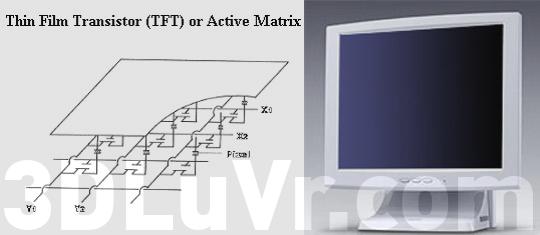 |
|||||||||
|
|
||||||||||||||||||
|
|
| Want to leave us a comment about the site or in general? Click here to access the form. |
 |
|
DTI3D - A journey through three dimensions by: Greg Hess Added on: Tue Sep 25 2001 |
|
| Page: 1 2 3 4 5 6 7 8 9 | |
This intensity controlled light passes through a group of color filters, which determine the density, contrast, and brightness of each color. Each pixel on an LCD has three filters, one for Red, Blue and Green. Originally there were more filters, but the institute for color correctness filed a suit against Purple, Orange, and Pink and somehow won in a long legal battle. (Their now being sued by rambus.)  The three filters and their respective TFT's make up the dot pitch of the monitor, or basically the individual pixels. These pixels are set as a fixed amount which is one of the reasons why the display gets so upset if you change it from its optimized resolution. When you change the resolution from the displays fixed amount, the display blurs/shrinks the image to reach the desired resolution. In older displays this causes a nasty effect, making the sharpest of images look as if your wearing beer googles. The later displays are better at changing resolutions, but its always recommended to run at your displays preset resolution/hertz. So with all this intense and utterly draining information on LCD displays the real question remains�..When will Greg finally realize he's not funny?� The dirty truth about CRT's and LCD's (Size does matter) With all the techno babble out of the way, there are but a very distinct advantages and disadvantages to the two technologies. CRTs tend to have refresh issues, to be heavier, to be power hungry (not coup, but watt), and to be relatively enormous. Also, CRTs tend to have around a 3-5 year lifespan, depending on the type of tube and use of the monitor. On the other hand CRTs have excellent gamma, color saturation, response rate, and can scale to virtually any resolution supported by the tube. LCD's are almost completely the opposite. LCD's are lighter, use less power, don't flicker, don't emit radiation, take up virtually no space at all, (Important in a family of 17), and are extremely sharp and bright. They also have problems with response times (noticeable in games), can contain dead pixels (Pixels which are forever forced to display a single color), and sometimes don't scale to other resolutions well. Even with its disadvantages, its quite apparent that LCD's are the way of the future. Especially when you sit down in front of one and actually have room for your rhino to run around on your desk. |
Best viewed in 1024x768 or higher,
using any modern CSS compliant browser.